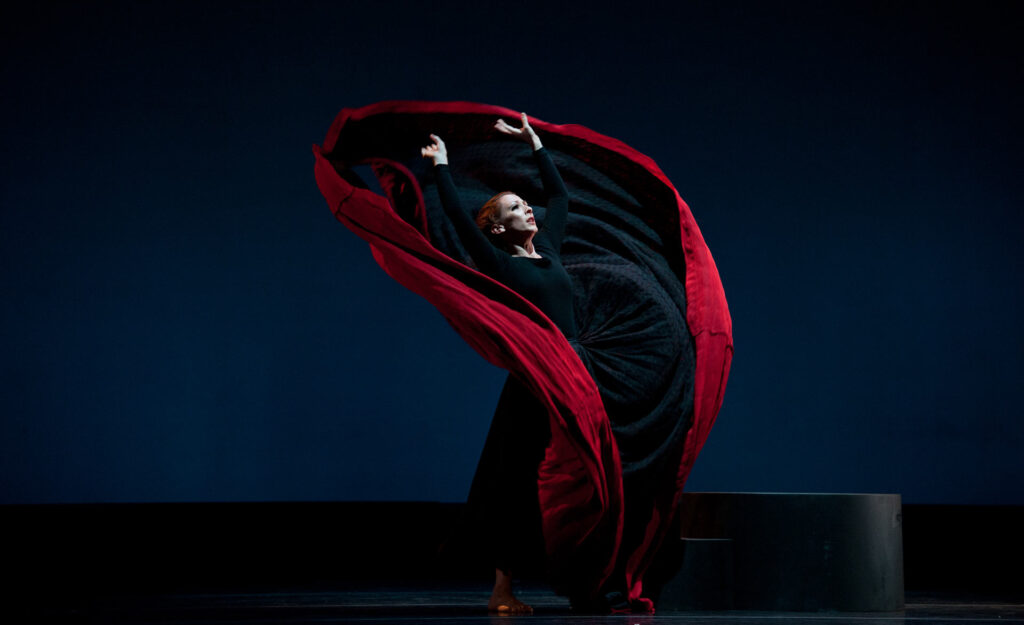Conscious Creative Ceremony
Tamur Tohver’s presentation at International Federation for Theatre Research yearly conference in Galway, in July 2021, based on Tamur’s PhD research on performing arts at Manchester Metropolitan University.
Before exploring how theatre becomes an elevated ceremony, let us consider two moments:
what are the manifestations of fear in the cooperation between actor and director, and also
how to elevate the performing craft to a level where duality (entertainment oriented at materialistic goals) is transformed to an elevated inner state, dissolving blockages in both the actor’s performance and the spectator’s reception, lifting an ordinary performance to the level of ceremony.

2
I rely here not only on my four decades of experience in theatre, coaching and yoga, but will draw on the discoveries and conclusions of other scholars, expanding the subject first from the director’s point of view and then, from the observer’s – from self-cultivation approach. This will also expound how and why I created the Zero Zone praxis.
blockages
The work of actor and performing arts scholar Meyer-Dinkgräfe, PhD confirms that the performance can reach higher states of consciousness and engage the spectator in more profound levels of imagination, where dualities disappear. Simply put – in this state the spectator is disengaged from all surroundings and therefore liberated from material blockages (sense of space and time), but also from personal ego-based prejudices, attitudes, pettiness, ignorance, judgement etc.[1] As the spectator receives their experiences organically via the performer (co-living (Stanislavski) the life of the character), the performer’s absorption into the character should be near absolute (studies have shown that during performance, the actor is only approximately 20% aware of the surroundings outside the limits of the production, both mentally and physically).
reincarnation or incarnation?
We can’t use the term ‘performer’, for in this view the actor does not remain on the level of presenting but moves to the plain of being. That is, not reincarnating (perezhivanie Russian, Stanislavski) but incarnating. Unfortunately, it is presently a rare occurrence for an actor to achieve 100% absorption in their acting flow.[2] And the reason behind wavering in this flow is fear.
_________________________
[1] Meyer-Dinkgräfe, 2005.
[2] Csikszentmihalyi, M. (1990) Flow. The Psychology of Optimal Experience. New York (Harper Perennial) 1990.
Nevertheless, most contemporary writings describe stage fright as an inevitable effect connected to performing, which is considered an individual problem of the performer rather than a consequence of and a common obstacle in rehearsing and devising. Additionally, the writings separate the director from the cast – intentionally or accidentally? Furthermore, fear is still recognised as an encouraging element in performing arts.
The main reasons behind why we still experience fear in performance and in the creative process
First, our professional attitude: desire for the achievement, not for the service. I’m not talking about religious service or material earnings (income); I’m talking about commitment, devotion. And this is a question of approach.
Second, we still perceive a hierarchical relationship in the rehearsal room. It is skewed either towards the authority and self-assertion of the director or the actor, rather than being based on genuine values happening here and now, experience and mutual respect. The old-fashioned thinking still persists: fear is an encouraging element, and the director is an employer.
Third – as practitioners, we have been experienced higher consciousness and are aware of the necessity of real presence in performance, but we are still not using it with full capacity. We still have our personal hesitations, preferences and confusions. Are we frightened of change in consciousness, or do we hesitate that we’ll never reach it?

It’s more ultimate than ultimate: I seemed to be part of a presence that stood behind me and was able to observe, not with my eyes, but with my total being, myself and the audience. It was a wonderful thing to leave not only the character but also this person who calls himself Ray Reinhardt. In a way, I was no longer acting actively, although things were happening. It was the closest I’ve ever come in a waking state to a mystical experience (Richards, 1977: 43).
1 ceremony
Ceremony itself is not merely a religious rite or observance. In the present day our understanding of ceremony that of a formal custom. At a contemporary wedding the bride and groom make a promise to each other, at a funeral we send our best wishes to accompany the departed on their final journey, or we celebrate the birth of a child. But in the very, very olden days, the ceremony included a plea or appeal to nature for rain to come and water the scorched field. There was a purpose and an address. Thus, ceremony is a ritual of sending a message, which affects every participant, and generally to that message an answer is received (most often individually), although the process is a collective one. In other words, that has been the purpose of a theatre performance throughout the times, even if today it has largely moved to digital streaming (which simultaneously weakens the joint sense and feeling of communion) and rather attempts to meet the requirements of quantity (number of performances, viewers per show, and a low budget). Naturally, a ceremony can take place privately, within oneself and entirely alone. But that is why we come to the theatre, to be elevated together.
performing flow
The performing flow and staying in it are significant components of the theatre ceremony. It creates an atmosphere and a sensory landscape; the message is delivered through the senses rather than by a process of mental discourse. In the world of professional performing arts, the actors are usually very experienced in the artisanal craft of their profession, yet they can still be daunted by the fright (read: switch in consciousness) that occurs upon falling out of the performing flow created during Absolute Performance (based on inner conviction and truth, realised through a directed change of consciousness).
zero zone praxis
Zero Zone praxis challenges the notion of productivity (read: current oversupply) and efficiency (sales and viewer numbers) as the hallmarks of success in contemporary performing arts. My view is that to survive the daily reality of the industry, one needs not to desire but to detach oneself from the achievement – give it up, if you like. Letting go of materialistic duality is not particularly easy, natural human caution and fear of the new holds us back. Zero Zone Praxis can be a help on this journey.
3 fear
It has been proven many times over that fear plays an integral part in the performing arts.[3] Fear is the primary component of stage fight, leading to lower creative potential and potentially significantly overshadowing the creative relationship between actor and director. While Gabbard (1979) indicates that stage fright is an intangible sense of communion between the performer and the audience; his fundamental conclusion that stage fright is mostly a fear of ‘not being enough‘ gives one of the most substantial reasons for conflict in the actor-director dyad. There is an important aspect to be noted here. Today, we are used to considering stage fright as part of the actor’s craft, for they are the one going on stage. In truth, directors suffer from this as well – subconsciously, each future performance is not only a product of their work, but also public judgement of it. Thus, both sides have a vital interest in how the performance does, and as soon as this interest remains egotistic, conflict arises – the ego begins to defend itself from inadequacy and using methods that are not always pleasant.
_____________________
[3] See Brennan, 2020; Arias, 2019; Robb, Due and Venning, 2018; Thomson and Jaque, 2017; Merlin, 2016; Maxwell, Seton and Szabo, 2015; Seton, 2010; Konjin, 2000.
Next, comes the pressure from the entertainment industry – am I enough to meet the demands of competition? In the modern world of increasing overproduction, emphasis is put on low budgets and short rehearsal periods, combined with a constant expectation of new material.
Western culture as a whole in its rationality denies the Miracle, even though the resurrection of Christ was one, and so are fairy tales. A miracle-free approach is impossible in theatre – it’s as if we don’t believe in what we do. But miracle is precisely what we create, each night. Miracles don’t fit into Excel spreadsheets; one can only attempt to tabulate its external shape.
10
As Stanislavski himself was affected by tremendous stage fright,[11] he presumably established a method which alleviates the performers’ fright by transforming acting from presenting to being, and gave way to a considerable change in the performing arts toward our innate nature. This is also why you experience fear if you are lying or pretending – you are separated from truth, which is natural for humans.
And this brings us back to the original nature of theatre. Only a truthful performance is receivable, and the higher the level of absorption in it, the stronger the delivery of its message and the effect of the art of performing. The purpose of theatre is a ceremonial reunion with the true, innate nature of humanity, the aim and its application, not mere entertainment. Yes, we can use it this way and even earn a living from it, but that is not the basic nature of theatre.
consistency and practice
Attention, Flexibility, Shifting Point, the importance of daily practice. My recent case studies with practising Zero Zone Praxis over the rehearsal and performance period (from March 2020 to July 2021) of Roheline nagu laulaks (Polygon Teater, 2020) confirmed that the first positive changes occur already within 30 days. Therefore – what if this splitting in the actor’s consciousness were understood as a productive skill, as a shifting point, rather than a destructive disorder?
________________
[11] Nemirovich-Danchenko was even forced to replace him in a leading part once, because Stanislavski was unable to memorise his lines (Merlin, 2016; Wegner, 1976). His inability to focus on the character both caused and magnified the fear. A closed circle.

11 ceremony
We do not need external procedures to commit a performance as a ceremony. Attending a higher level of consciousness secures the permanent flow via complete absorption. This will carry the performer with the audience to non-duality, to a higher sensibility level, where there are no blockages for receiving the message. We only have to let go of materialistic attachments, fear, paranoia, ego, a false sense of superiority or inferiority, and things beyond our control (the opinions of others, et al). This is the shifting point, which is most difficult to accomplish, especially at the time of performance. How to execute this shifting and alleviate fear is explained in the ZZ exercises.
In conclusion
Before the artisanal craft can be elevated, we should work on improving personality. In terms of an effective technique to alleviate anxiety and enhance the actor-director dyad, emotion-guiding is the most effective technique. If the director creates and maintains a coaching flow by practising ZZ praxis throughout the rehearsal period, the creative exchange in the process will be enriched and achieves a range of goals by creating the ability to develop higher artistic freedom in the sense of absorption and liberation. By cultivating themselves in a horizontal creative practice, the actor and the director enter a level of heightened sensitivity, both in ethics and craft (Stanislavskian ethics, remember?). Individuals involved in such practices achieve a highly subtle level of connection and perception.


